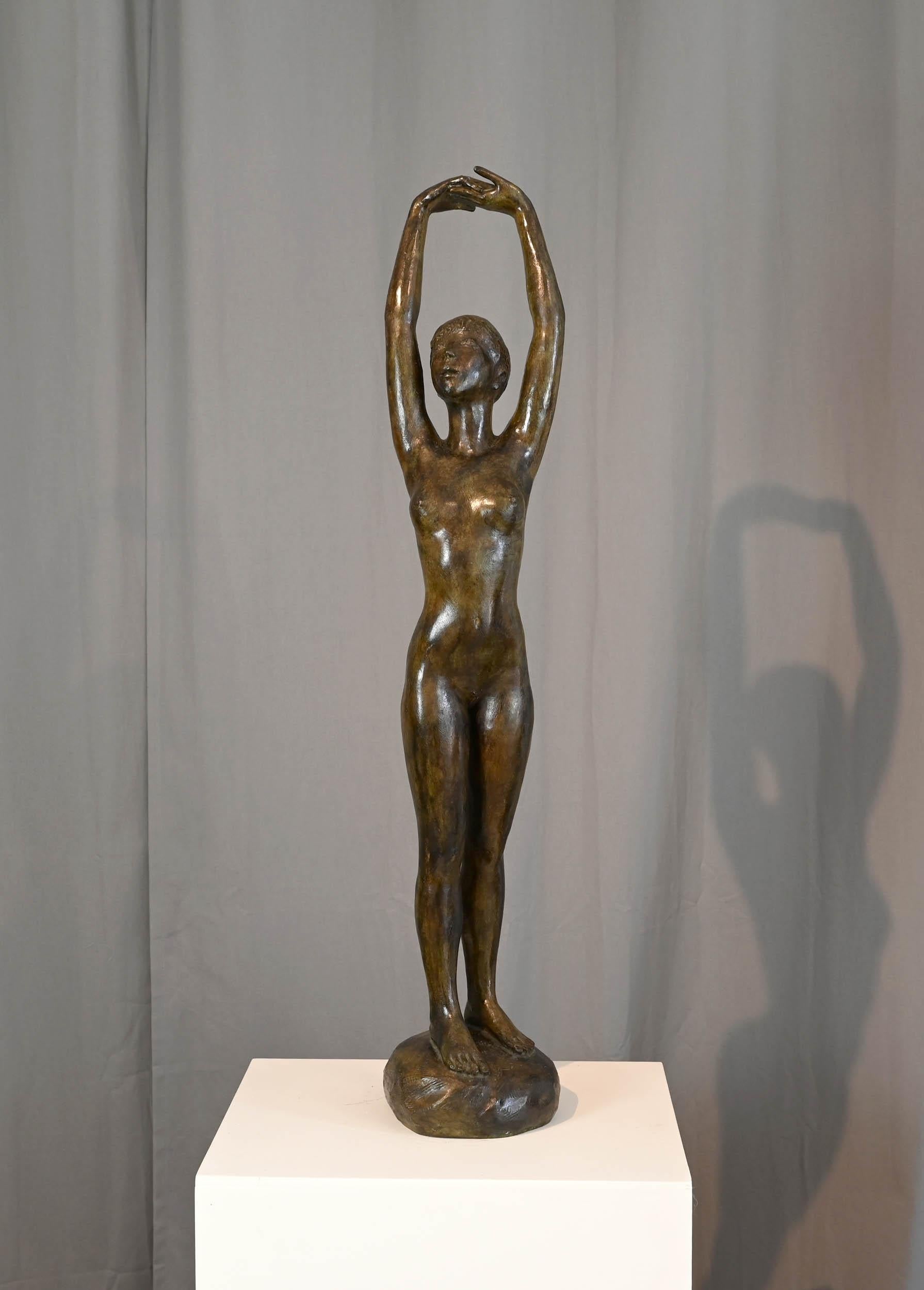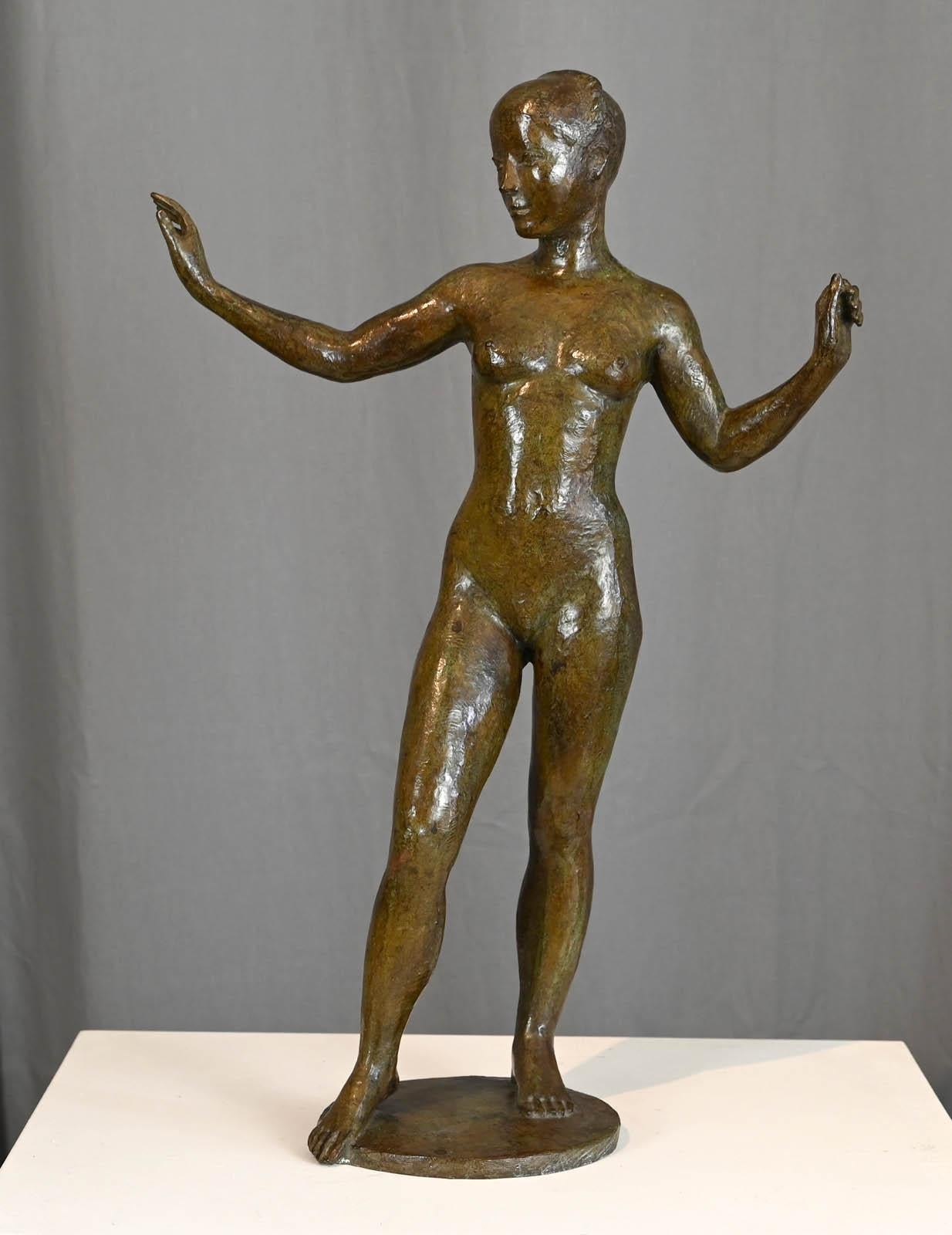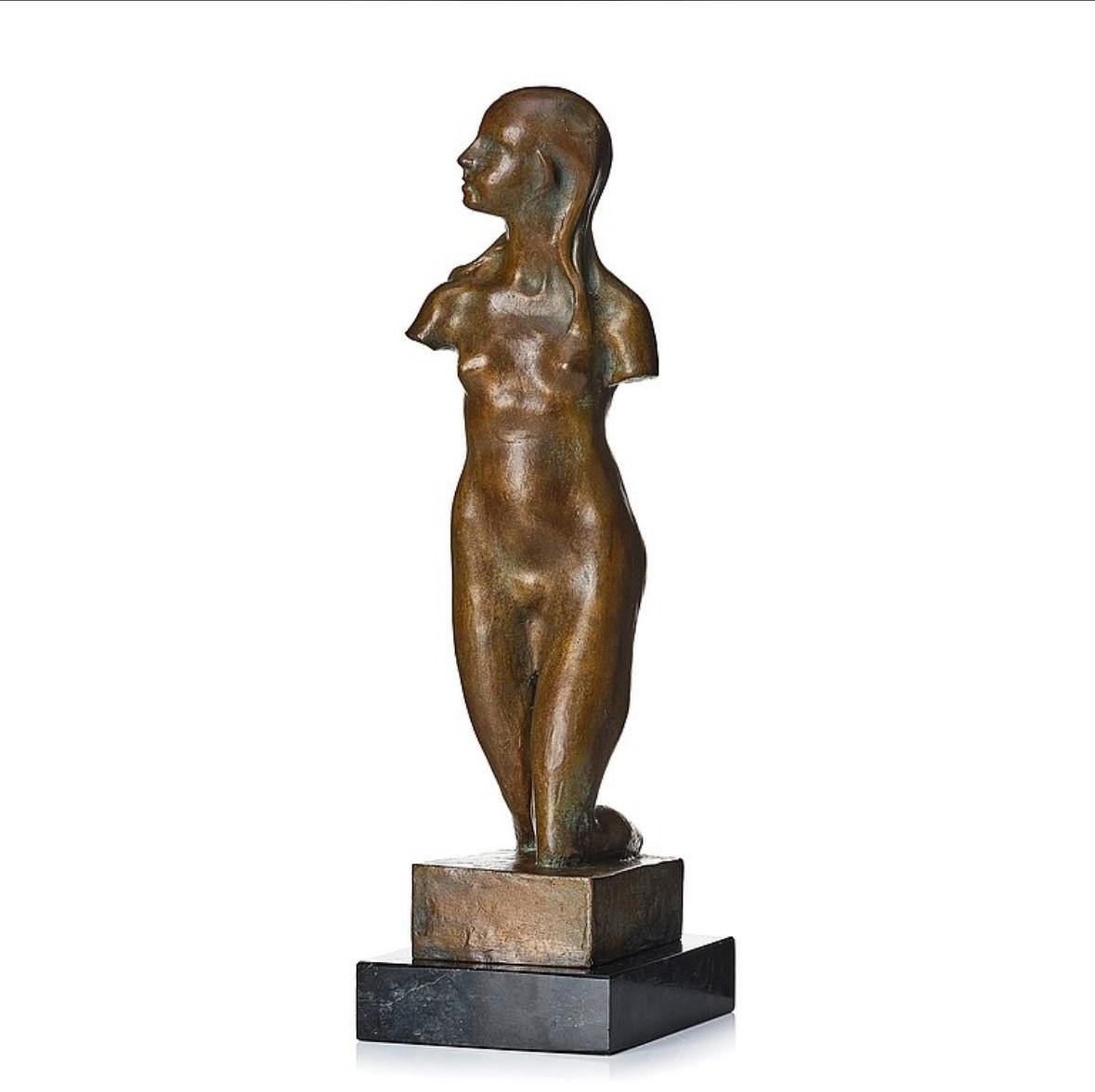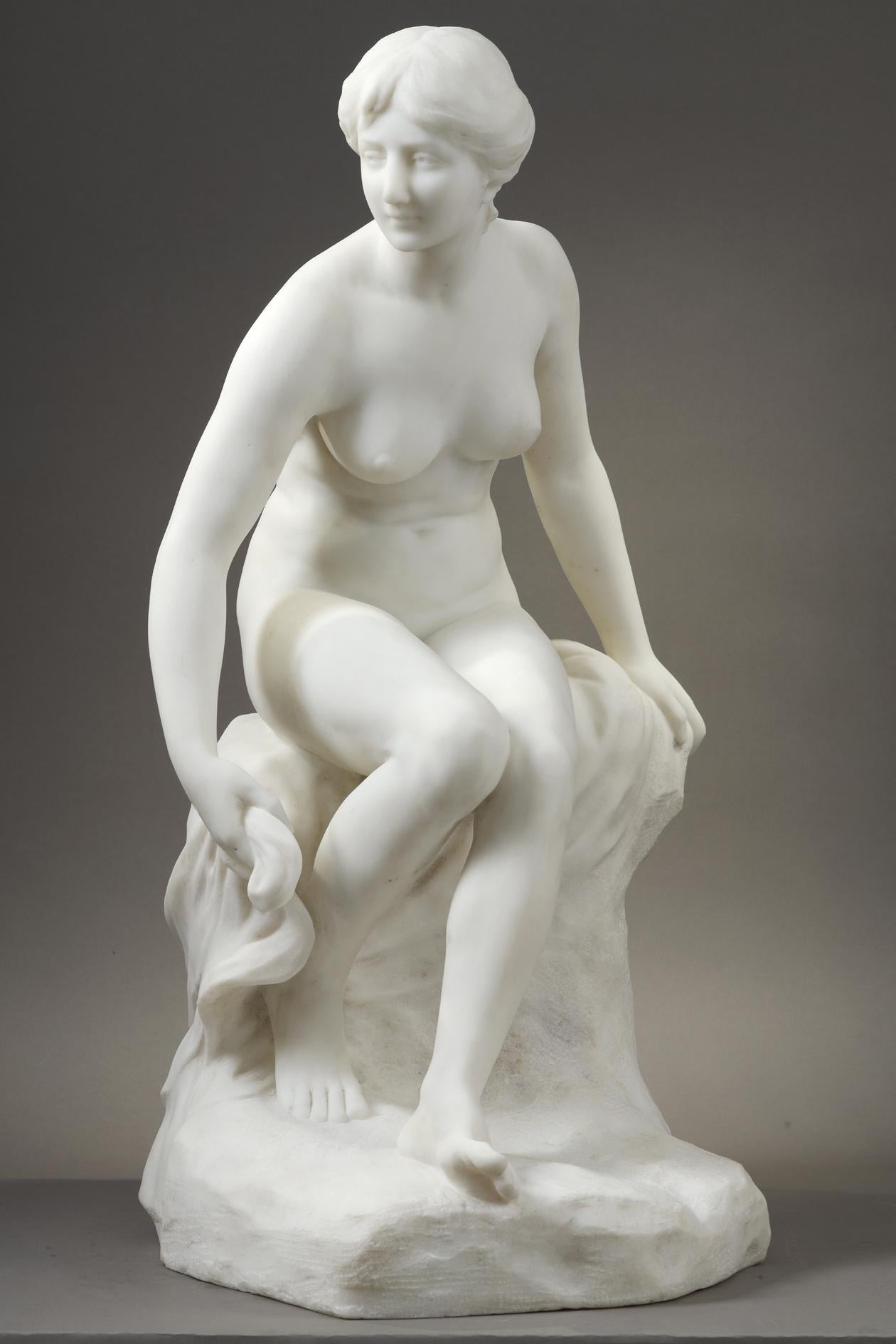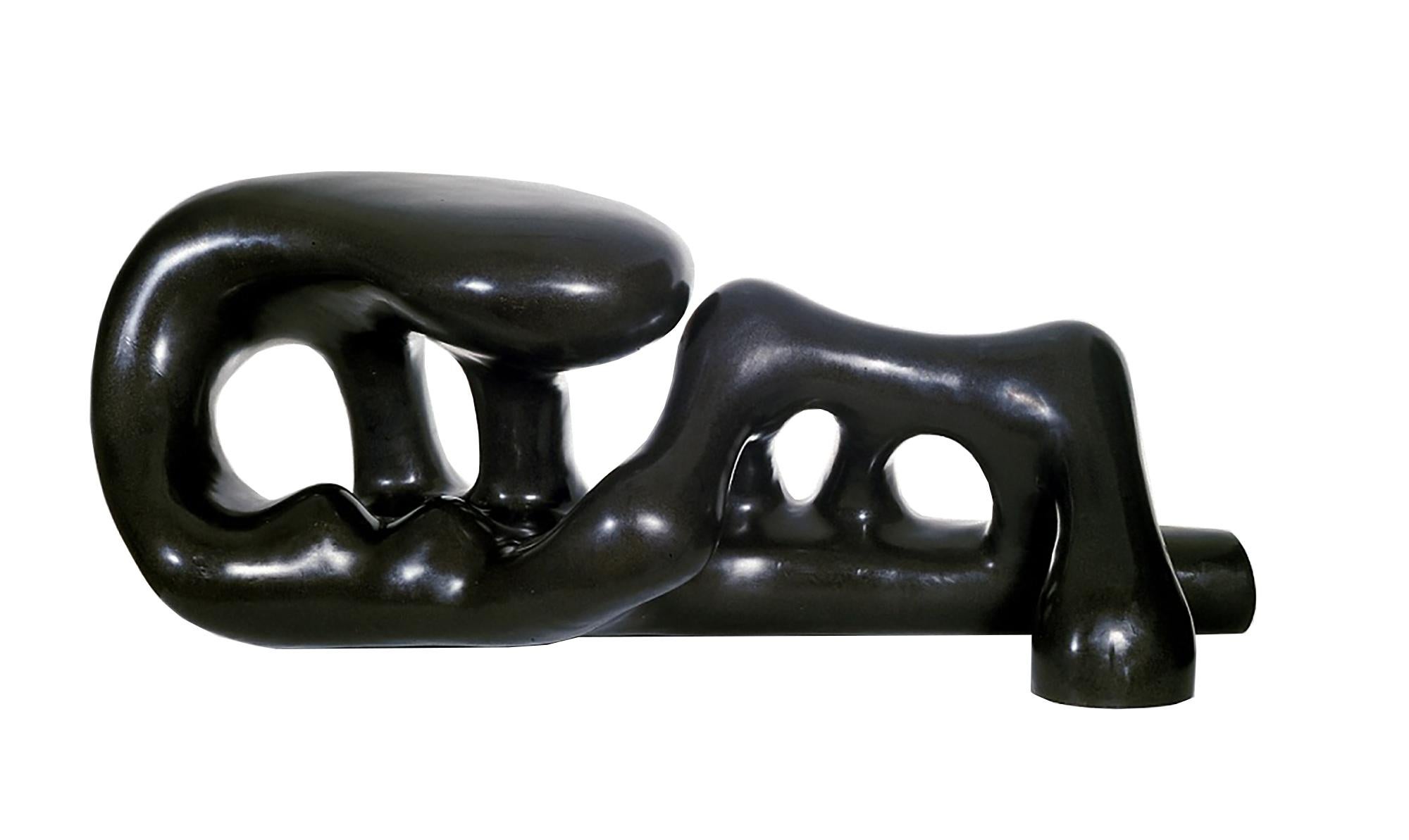Want more images or videos?
Request additional images or videos from the seller
1 of 19
Albert-Ernest Carrier-BelleuseSnake Charmercirca 1860
circa 1860
About the Item
Bronze sculpture with a nuanced dark brown patina
signed on the base "A. Carrier"
inscribed on a front plaque "Charmeuse de Serpents par Carrier-Belleuse"
France
circa 1860
height 80,5 cm
Biography :
Albert-Ernest Carrier de Belleuse known as Carrier-Belleuse (1824-1887) was one of the most prolific artists of the century and had the greatest successes under the Second Empire, enjoying the personal support of Napoleon III. His work was greatly influenced by the style of the Italian Renaissance and that of the 18th century, which he helped to bring up to date.
In 1837, the young Carrier-Belleuse apprenticed in the workshop of the engraver Bauchery. He was admitted soon after to the goldsmith Jacques Henri Fauconnier. Through François Arago, he met the sculptor David d'Angers who facilitated his admission to the School of Fine Arts. Carrier-Belleuse entered it in 1840. Noted for his skill by the great bronze companies in Paris such as Barbedienne and Denière, he soon received numerous orders for models for candelabras, pendulums, fittings for fireplaces, etc. In 1848, probably at the initiative of François Arago, who became head of state, he received his first public order for a small statue of "Mademoiselle Rachel singing La Marseillaise". In 1851, he appeared for the first time at the Salon of French Artists, where he presented two bronze medallions. From 1851 to 1855, Carrier-Belleuse stayed in England, in Stoke-on-Trent where he served as director of the modeling and drawing school of the Minton house, a large porcelain manufacturer.
Back in France, Carrier-Belleuse moved to Paris in a large workshop located 15 rue de la Tour d´Auvergne. From 1857, he made regular sendings to the Salon and became famous thanks to the success of large marbles, such as the "Bacchante" exhibited at the Salon in 1863, and acquired by Napoleon III, "Angelica" (1866) or even "Hebe asleep" (1869). At the Salon of 1867, his group entitled "Messiah" earned him the medal of honor of sculpture. It was acquired by the State to adorn the Chapel of the Virgin in the Saint-Vincent-de-Paul church.
Carrier-Belleuse acquired a great reputation in parallel for his terracotta busts which, in many respects, recall those of 18th century artists. He made portraits of a large number of celebrities of his time. He produced, among others, the busts of Napoleon III, Renan, Thiers, Grévy, Arago, Marguerite Bellanger, Théophile Gautier, Honoré Daumier, Delacroix, Hortense Schneider, Réjane… He also modelled numerous busts of mythological inspiration and historical and artistic portraits like Marie Stuart, Shakespeare or even Mozart.
Carrier-Belleuse used and trained in his workshop in the rue de la Tour d´Auvergne many young talented artists such as Alexandre Falguière, Jules Desbois, Eugène Delaplanche, Jules Dalou or Joseph Chéret; but he was best known for having been the master of Auguste Rodin who entered his studio as a practitioner in 1864.
Carrier-Belleuse devoted himself a lot to decorative sculpture. He contributed to the decorations of many important buildings. We owe him in particular the caryatids of the Renaissance theater in Paris, the pediment of the main entrance to the Banque de France, the stucco ceilings of the Lesdiguières and La Trémoïlle pavilions at the Louvre Palace, the frieze of the Palais de la Bourse in Brussels, or the decoration of the Hôtel de la Païva on the Champs-Elysées in Paris. He also received State commissions for monuments: that of Jean-Jacques Rousseau in Montmorency, of Alexandre Dumas, in Villers-Cotterêts, of Masséna in Nice. Abroad, he produced the equestrian statue of Michael the brave in Bucharest and the tomb of José de San Martín in Buenos Aires.
In 1873, Carrier-Belleuse took part in the construction of the Paris Opera house, directed by his friend Charles Garnier. He created the two monumental torchieres flanking the grand staircase in the main hall and the caryatids of the chimney of the grand foyer. In 1875, he was appointed director of works of art at the Porcelain Manufacture de Sèvres. He imprinted on it a very modern impulse which manifested itself in the creation of a complete range of vases.
- Creator:Albert-Ernest Carrier-Belleuse (1824 - 1887, French)
- Creation Year:circa 1860
- Dimensions:Height: 31.7 in (80.5 cm)Width: 9.06 in (23 cm)Depth: 11.03 in (28 cm)
- Medium:
- Movement & Style:
- Period:
- Condition:
- Gallery Location:PARIS, FR
- Reference Number:

About the Seller
5.0
Vetted Seller
These experienced sellers undergo a comprehensive evaluation by our team of in-house experts.
Established in 1992
1stDibs seller since 2023
Typical response time: 1 to 2 days
- ShippingRetrieving quote...Ships From: PARIS, France
- Return PolicyA return for this item may be initiated within 3 days of delivery.
More From This SellerView All
- Diana with an arrowBy Albert-Ernest Carrier-BelleuseLocated in PARIS, FRDiana with an arrow by Albert-Ernest CARRIER-BELLEUSE (1824-1887) Bronze sculpture with a dual light and dark brown patina signed on the base "Carrier-Belleuse" inscribed on a front plaque "Diane à la Flèche par Carrier-Belleuse (Sculptr)" France circa 1870 height 83 cm arrow added probably in the 20th c. Biography : Albert-Ernest Carrier de Belleuse known as Carrier-Belleuse (1824-1887) was one of the most prolific artists of the century and had the greatest successes under the Second Empire, enjoying the personal support of Napoleon III. His work was greatly influenced by the style of the Italian Renaissance and that of the 18th century, which he helped to bring up to date. In 1837, the young Carrier-Belleuse apprenticed in the workshop of the engraver Bauchery. He was admitted soon after to the goldsmith Jacques Henri Fauconnier. Through François Arago, he met the sculptor David d'Angers who facilitated his admission to the School of Fine Arts. Carrier-Belleuse entered it in 1840. Noted for his skill by the great bronze companies in Paris such as Barbedienne and Denière, he soon received numerous orders for models for candelabras, pendulums, fittings for fireplaces, etc. In 1848, probably at the initiative of François Arago, who became head of state, he received his first public order for a small statue of "Mademoiselle Rachel singing La Marseillaise". In 1851, he appeared for the first time at the Salon of French Artists, where he presented two bronze medallions. From 1851 to 1855, Carrier-Belleuse stayed in England, in Stoke-on-Trent where he served as director of the modeling and drawing school of the Minton house, a large porcelain manufacturer. Back in France, Carrier-Belleuse moved to Paris in a large workshop located 15 rue de la Tour d´Auvergne. From 1857, he made regular sendings to the Salon and became famous thanks to the success of large marbles, such as the "Bacchante" exhibited at the Salon in 1863, and acquired by Napoleon III, "Angelica" (1866) or even "Hebe asleep" (1869). At the Salon of 1867, his group entitled "Messiah" earned him the medal of honor of sculpture. It was acquired by the State to adorn the Chapel of the Virgin in the Saint-Vincent-de-Paul church. Carrier-Belleuse acquired a great reputation in parallel for his terracotta busts which, in many respects, recall those of 18th century artists. He made portraits of a large number of celebrities of his time. He produced, among others, the busts of Napoleon III, Renan, Thiers, Grévy, Arago, Marguerite Bellanger, Théophile Gautier, Honoré Daumier, Delacroix, Hortense Schneider, Réjane… He also modelled numerous busts of mythological inspiration and historical and artistic portraits like Marie Stuart, Shakespeare or even Mozart. Carrier-Belleuse used and trained in his workshop in the rue de la Tour d´Auvergne many young talented artists such as Alexandre Falguière, Jules Desbois...Category
1870s French School Nude Sculptures
MaterialsBronze
- BatherLocated in PARIS, FRBather by Etienne Hachenburger (19th-20th C.) Sculpture in white Carrara marble Signed on the side of the base "E. Hachenburger" A simiilar model was exhibited at the Paris Salon oh...Category
Early 1900s French School Nude Sculptures
MaterialsMarble
- The SongBy Félix CharpentierLocated in PARIS, FR"The Song" by Félix Charpentier (1858-1924) A very fine bronze sculpture with nuanced dark brown patina Signed "Fx. Charpentier" Cast by "E. Colin & Cie Paris" France around 1900 he...Category
Early 1900s Art Nouveau Figurative Sculptures
MaterialsBronze
- Nature unveiling in front of ScienceBy Louis Ernest BarriasLocated in PARIS, FRNature unveiling in front of Science by Louis-Ernest Barrias (1841-1905) Bronze sculpture with multiple patina. Signed "E. Barrias" on the side of the base cast by "Susse Frères" (foundry mark and stamp) The model of this statue was commissioned in 1889 to decorate the new medical school in Bordeaux. When he had finished the first version in white marble for the school, Barrias designed a second marble and onyx statue in 1899 for the ceremonial staircase of the Conservatoire des Arts et Métiers in Paris. France circa 1900 height 58 cm Biography : Louis-Ernest Barrias (1841-1905) was a French sculptor . He came from a family of artists. His father was a porcelain painter and his older brother, Felix-Joseph Barrias, a recognized painter. Louis-Ernest Barrias entered the School of Fine Arts in Paris in 1858, he abandoned painting to move towards sculpture under the direction of François Jouffroy. In 1864, he won the Prix de Rome, on the theme of "The Foundation of Marseille", and was engaged on the site of the Paris Opera house. He later produced many sculpted works, most of them in marble. In 1881, Louis-Ernest Barrias was awarded a medal of honor of the fine arts and named knight of the Legion of Honor in 1878, then promoted officer in 1881 and commander in 1900. The artist replaced Auguste Dumont at the Institute in 1884, then succeeded Jules Cavelier as a professor at the School of Fine Arts, where, among his most notable students, there were Victor Ségoffin, Charles Despiau and Paul Landowski.Category
Early 20th Century Art Nouveau Figurative Sculptures
MaterialsBronze
- ApolloBy Henri BouchardLocated in PARIS, FR"Apollo" by Henri Bouchard (1875-1960) An Art Deco period masterpiece! Exceptional bronze sculpture with a golden-brown patina Signed " H. Bouchard " Unique piece This work personifies Apollo, god of the Arts. Represented here as Apollo Musagète, leader of the procession of muses and winner of the serpent Python. This subject was commissioned to adorn the entrance to the Palais de Chaillot in Paris, and whose monumental bronze is still exhibited there. To participate in the Venice Biennale in 1938, Henri Bouchard had reduced in 1937 the large Apollo of the Palais de Chaillot, which had not yet been installed. Vintage cast by Bisceglia (cast founder stamp) made during the artist's lifetime. Incised dedication below signature : " à mon cher ami E. Sandoz " This is a unique cast made for the sculptor Edouard-Marcel Sandoz (1881-1971). This cast was exhibited at the 1938 Venice Biennale. France 1937 height : 82 cm width : 45 cm depth : 30 cm weight : 31,2 kgs Stickers under the bronze cast : - Sticker mentioning that this cast has been exhibited at the Venice Biennale of 1938 under the number 354 ("Biennale Internaz. d'Arte Venezia – 1938 – XVI – 354"). - Sticker mentioning that this cast went through Italian customs ("ne – merci – dogana italiana – visitate - 9622") - Damaged Sticker mentioning the name ("A…") and the address ("25…") of the owner of the cast (maybe for the workshop "Atelier Henri Bouchard", 25 rue d’Yvettes, 75016 Paris). Provenance : - Edouard-Marcel Sandoz, Paris, according to the dedication. - Property from the Collection of Seymour Stein (entrepreneur and founder of Sire Records, famous American record label ; and avid collector of 19th and 20th century fine art...Category
1930s Art Deco Figurative Sculptures
MaterialsBronze
- Daytime, marble sculptureLocated in PARIS, FR"Daytime" by James PRADIER (1790-1852) Rare sculpture made in white Carrara marble France circa 1840 height 100 cm diameter of base 29 cm Listed in "Catalogue raisonné, James Pradi...Category
1840s Academic Nude Sculptures
MaterialsMarble
You May Also Like
- VictoireLocated in LE HAVRE, FRJacques COQUILLAY (né en 1935) Victoire Original bronze Size : 105 x 22 x 20 cm Copy No. 1/8 Signature and numbered on the base. Original bronze made with “lost wax” The edition o...Category
Early 2000s French School Nude Sculptures
MaterialsBronze
- MarieLocated in LE HAVRE, FRJacques COQUILLAY (né en 1935) Marie Original bronze Size : 56x39x17cm Copy No. 4/8 Signature and numbered on the base. Original bronze made with “lost wax” The edition of the bro...Category
Early 2000s French School Nude Sculptures
MaterialsBronze
- Female torsoLocated in Täby, SEGunnar Knut Nilsson, born 1904 in Karlskrona, died 1995 in Versailles in France, was a Swedish sculptor. Gunnar Nilsson studied watercolor painting and modeling at the Technical Vocational School in Karlskrona in 1918-19 and on his own in addition to working as a clerk at Finspångs Metallwerk. His debut exhibition was in Finspång in 1927. With the help of a local fundraiser, and after the encouragement of Carl Eldh, he traveled to Paris in 1928 to study sculpture for, among others, Charles Despiau and Paul Niclausse. In Paris he socialized with Bror Hjorth, whose former studio he also rented, Carl Frisendahl and Alberto Giacometti. He came to belong to "Le groupe des Neuf'' with Paul Cornet...Category
1950s French School Nude Sculptures
MaterialsBronze
- Agustín Cárdenas, Le Repos Passionné, 1989, Bronze. Edition 7/7By Agustín CárdenasLocated in Miami, FLAgustín Cárdenas Le Repos Passionné, 1989 Bronze. Ed. 7/7 60 x 145 x 51.5 cm 23.6 x 57 x 20.2 in. The artwork is accompanied by a certificate of aut...Category
1980s Futurist Figurative Sculptures
MaterialsBronze
- Animal Bronze: Lying eagle by Alberic Collin (close friend of Rembrandt Bugatti)Located in Gent, VOVNumbered 1/8 Cast Fonderie Rocher A fine cast with a vivid green patina of a bird of preyCategory
1930s Nude Sculptures
MaterialsBronze
- Roaring LionnessLocated in Gent, VOVA fine quality, twentieth-century bronze model of a roaring lioness by Alberic Collin (Belgian 1886-1962). Prior to casting by the Valsuani foundry it w...Category
1930s Art Deco Figurative Sculptures
MaterialsBronze
